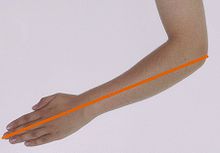Flemish ell
| Ell | |
|---|---|

The ell was originally a cubit, later replaced by the cloth-ell or "double ell".
|
|
| Unit information | |
| Unit of | Length |
| Unit conversions | |
| 1 in ... | ... is equal to ... |
| Inches | 18 |
An ell (from Proto-Germanic *alinō, cognate with Latin ulna) is a unit of measurement, originally a cubit, i.e., approximating the length of a man's arm from the elbow ("elbow" means the bend or bow of the ell or arm) to the tip of the middle finger, or about 18 inches (457 mm); in later usage, any of several longer units. In English-speaking countries, these included (until the 19th century) the Flemish ell ( 3⁄4 of a yard), English ell ( 1 1⁄4 yards) and French ell ( 1 1⁄2 yards), some of which are thought to derive from a "double ell".
An ell-wand or ellwand was a rod of length one ell used for official measurement. Edward I of England required that every town have one. In Scotland, the Belt of Orion was called "the King's Ellwand".
Several national forms existed, with different lengths, including the Scottish ell (≈37 inches or 94 centimetres), the Flemish ell [el] (≈27 in or 68.6 cm), the French ell [aune] (≈54 in or 137.2 cm) the Polish ell (≈31 in or 78.7 cm), the Danish alen (24 Danish inches or 2 Danish fod: 62.7708 cm), the Swedish aln (2 Swedish fot ≈59 cm) and the German ell [Elle] of different lengths in Frankfurt (54.7 cm), Cologne, Leipzig (Saxony) or Hamburg.
Select customs were observed by English importers of Dutch textiles: although all cloths were bought by the Flemish ell, linen was sold by the English ell, but tapestry was sold by the Flemish ell.
...
Wikipedia
